|
Glamorized violence, as part of hegemonic hypermasculinity is evident throughout popular music videos. It is portrayed both as male dominance and female submission across almost every mainstream genre of music in the U.S. While socializing men into positions of dominance, these images simultaneously socialize women into being passive, weak, and subordinated victims of aggression.
This violent male gaze is a part of the system of patriarchy that has been well-documented by scholar Sut Jhally in Dreamworlds 3: Sex, Desire, and Power in Music Videos. Sut Jhally argues that one of the primary factors contributing to men carrying out violence against women, as well as other men, is the repetition of stories or narratives that masculinity involves an emphasis on dominance through attaining exaggerated muscles, physical strength, aggression, and control over women’s bodies. This specific brand of commercial masculinity, which he terms hypermasculinity, defines a man’s self-worth and success in how he does his gender. Jhally argues that one technique frequently used to gain the viewer’s attention in music videos is to produce videos shot with women backup dancers and lead vocalists in clothing and with camera angles that draw the focus away from seeing them as people or artists and more towards the emphasis and exploitation of their individual body parts. 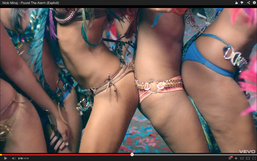
An excellent example of this physical dismemberment and sexual objectification of female musicians’ bodies can be found in the recently popular music video “Pound the Alarm” by Trinidad artist Nicki Minaj, which has had over 70,000,000 views and 328,000 likes on You Tube alone in the past 6 months. “Pound the Alarm,” which is set in the artist’s country of birth, Trinidad, tells a story of the celebration of the native Trinidad holiday Carnival from a sexually objectifying Western male gaze. The narrative is told in fast-paced, images of racially diverse female back up performers and Nicki Minaj dancing through the streets and beaches of Port of Spain, Trinidad. The moments where the story slows down and freezes primarily features shots of these women’s bodies that cut off their heads, focus on their shaking, dismembered breasts, stomachs, and buttocks, which have been mostly exposed in bikinis, and are accompanied by lyrics from Nicki Minaj such as “What do I have to do to show these girls that I own them?,” and involve the smiling and laughing back up dancers silently complying to Nicki’s commands to be “turned out” on the streets. The stilling of the images of the girl’s body parts removed from their faces, which are covered at an angle from the floor up close, or in a grinding mess, is combined with the repeated image of men dressed in blue costumes cracking whips and breathing fire. This happens while Nicki Minaj and the other girls submit images to them of their body parts, which sends a message that female subordination through sexual objectification and aggressive acts is normal, glamorous, and even enjoyed by both men and women.
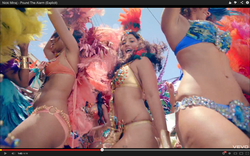
In light of the heated discourse in the news media on the growing trend of violence committed against large groups of people in public spaces such as schools and movie theaters (i.e. the December 14th, 2012 school shooting committed by Adam Lanza in Newtown, Connecticut, the recent homicide at a movie theater in Aurora, Colorado on July 2012 and the April 2007 mass killing at Virgina Tech State University), some psychologists and mental health experts propose that these tragedies could have been prevented if the mental health system had more resources from the government to make sure that individuals with signs of mental illness are not overlooked. While this is certainly true and some commentators have pointed out that another contributing factor might be the amount of violence in television, video games, and movies that children are normalized to, there has not been any extensive discussion of violence and aggression in the mainstream news as an issue resulting from the way that boys are taught to assert their masculinity. There has been no mention of a crisis in relation to male gender socialization, even though for the past 30 years the perpetrators of these mass shootings have been entirely male.
From a sociological perspective, one preventative measure to mass homicides may be to consider the extent that violent images of masculinity have become so accepted in society. We are not sensitized to how males with aggressive behavior tendencies may act when in psychological distress. While we may perceive these actions as that of ‘real’ men, we would not interpret their aggression as a pathological disturbance in the same way that we would if that person was a woman. Sensitization by the mental health system to aggressive behavior in boys as a symptom of the unhealthy psychological effects of gender socialization could prevent future mass killings by men, many of whom probably had some aggressive tendencies or plans of action that went overlooked prior to the actual violence. This prevention may only work once we are able to first stop sending the message to males with mental health issues, as well as their male peer groups, that violence is what it takes to be successful, powerful, and ‘real’ men.
Elizabeth Dickson
Elizabeth Dickson is a student at Ohio Wesleyan University, where she is double-majoring in Psychology and Sociology.
Andre Sookdar
2/6/2013 05:51:34 am
This "analysis" is an insult to Trinidad and our culture. Would you dare call a Native American a savage due to their customs and rites? Putting the pop music aside, Minaj's video highlights key aspects of Trinidad's Carnival and our culture. The author is commenting without having done one iota of research into our island's history or into the significance of the characters portrayed.
Chris
3/4/2013 08:04:31 am
As a Trinidadian and an ex-media student, I'm going to let you know that her article is not meant to slam our culture. All she did was took a theory written by Sut Jhally and juxtapositioned it against some imagery in order to illustrate something. She could have also done it using a random rap video as an example. I've studied Laura Mulvey's idea of the 'male gaze' and had to do a similar assignment.
Mark Dates
3/28/2013 06:47:14 am
yunno that would make sense if she didn't say things like: "The men are portrayed as aggressive, demonic blue creatures who set fire to and whip Nicki Minaj and the female dancers." when she doesn't fucking understand the cultural significance of old mas, and what Jab Jab and jab molassie characters represent in our culture! it's ridiculous!!
JustMeThinks
3/28/2013 09:44:35 am
She clearly didn't -mean- to slam Trinbagonian culture because she is obviously unaware that any aspects of the culture are actually present in the video.
CG Smith
3/28/2013 07:55:16 am
Andre,
Caroline Mair
2/6/2013 06:38:19 am
"...[T]he repeated image of men dressed in blue costumes cracking whips and breathing fire. This happens while Nicki Minaj and the other girls submit images to them of their body parts, which sends a message that female subordination through sexual objectification and aggressive acts is normal, glamorous, and even enjoyed by both men and women." Perhaps the writer should do some research in and understand the historical significance of the 'blue devil' character in Trinidadian Carnival folklore before extemporising ad nauseum and in ignorance about a culture she does not understand. Perhaps she should analyse cultural norms in her own country, such as the glorification of violent Hollywood movies and video games, before utilising an entirely different and disassociated trope such as Trinidadian Carnival heritage, to extrapolate commentary on mass homicides in her own said country. One has absolutely nothing to do with the other. This is exceedingly poor research and irresponsible anaylsis indeed.
Belle
10/16/2013 04:05:12 am
What is the significance of the 'Blue Devil' character in Trinidadian Carnival folklore? And do you happen to know about the cultural significance of old mas, and what Jab Jab and jab molassie characters represent as well? I am fairly ignorant to these subjects but I would like to get a better understanding of where you and other commenters are coming from.
Christie
2/6/2013 08:45:32 am
"While I generally agree with the much of the analysis, as someone living in Trinidad I'm pretty disappointed at how narrow the scope of this article it is. I agree with Sam Doyle: not much is added to existing discourse here. Perhaps the author should have done more research. The men aren't arbitrarily portrayed as "demonic blue creatures". The are playing traditional mas characters called Blue Devils. A character that has it's own history; a history that naturally intersects with race and class. Exploring that could have given the article more depth.
Renee
2/6/2013 09:59:57 am
Just a couple of corrections- Newtown was December 14th, I will never forget that date as long as I live. You have the murder's name wrong, but he is not worth naming anyway. And I totally agree that we have issues with the way we treat our male population and the way that expected behaviors are presented to them. The was one female mass murderer, however. She killed former coworkers at a post office.
Admin
2/6/2013 11:11:18 am
Thanks, Renee! We fixed the typos.
Dinda
2/6/2013 05:45:32 pm
I hate it when people nitpick at an article and don't seem to understand the main message, sure the author didn't really dwell into the cultural aspect of nicki minaj's video and connecting such a silly video to homicide is a stretch however it has a certain shock value that I appreciated. Young boys today watch these sort of music videos with rappers surrounded by nearly naked girls and often these videos are filled with violence. Young boys learn that they should be dominant to be, as the article pointed out, "real men". Race,class or culture doesn't really mean anything in this context. It doesn't matter what race the artist is making the video and it doesn't matter what race, culture or class the kids that watch them come from, they just see someone cool and want to be cool like them. 2/7/2013 03:58:47 am
Yep! A great nice video for a Carnival in the caribbean island, ant the usual Betty Crocker puritan parroquial feminist trash 'analysis' wondering why all men figures are not just eunuchs... 3/18/2013 10:44:59 pm
Pro tip - next time you want to critique violence and misogyny in White American culture, criticize it in YOUR culture, instead of projecting it on the culture of others.
Chris
3/18/2013 10:46:42 pm
Steupes. Read my comment. Comments are closed.
|
.
.
Tags
All
|
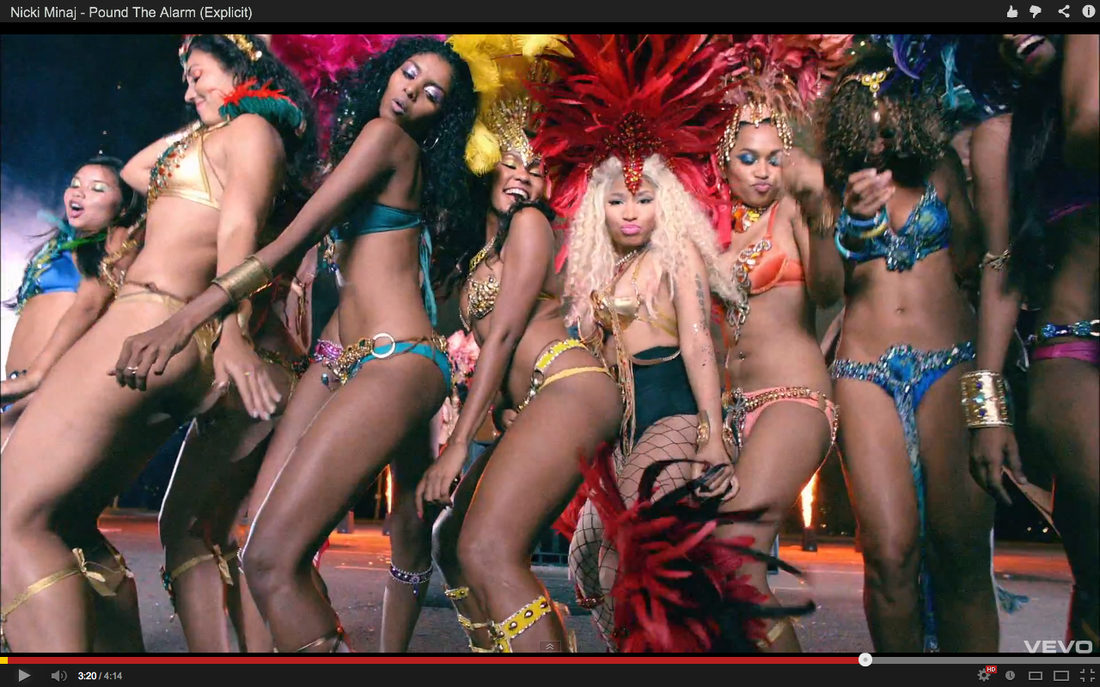
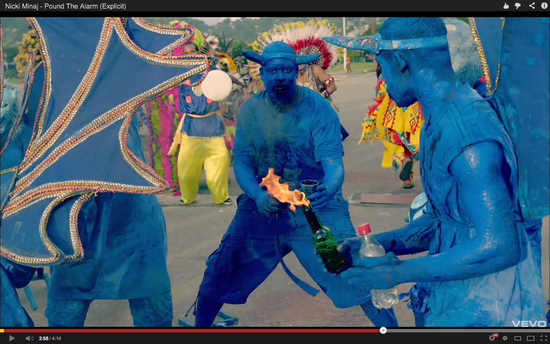
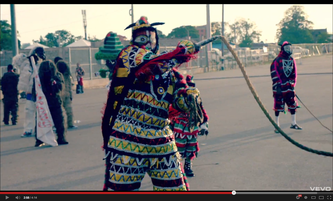
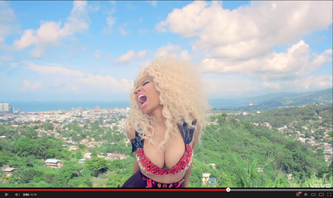
 RSS Feed
RSS Feed